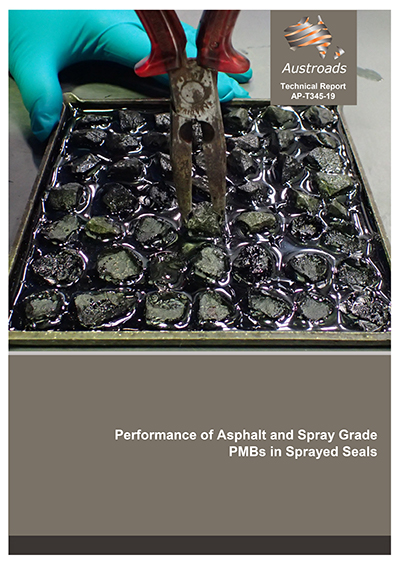Pavement

- Publication no: AP-T345-19
- ISBN: 978-1-925854-22-0
- Published: 10 July 2019
- PDF (free) Download
The Australian polymer modified binder (PMB) specification (AGPT/T190) currently requires different binder grades to be used in sprayed sealing and asphalt applications. This study compared the sprayed seal performance of PMBs representing four AGPT/T190 grades (i.e. S20E, A20E, S25E and A15E) to determine whether the use of S20E or A20E grade PMBs, or S25E or A15E grade PMBs, had a significant effect on sprayed seal performance. This work was conducted to complement asphalt performance comparison work which was performed using the same binders in 2017–18.
Samples of each of the representative PMBs were subjected to four different laboratory sprayed seal performance tests which represented different stages in the construction/life of a sprayed seal. The results of these tests appeared to indicate that S20E and A20E grade PMBs, as well as S25E and A15E grade PMBs, would be expected to perform similarly in sprayed seals.
Based on the results of sprayed seal performance comparisons, and asphalt performance comparisons conducted in 2017–18, it appears feasible to merge the S20E and A20E PMB grades, as well as the S25E and A15E PMB grades, in an updated version of AGPT/T190. Specification requirements have been proposed for the merged PMB grades.
- Summary
- 1. Introduction
- 2. Background
- 2.1 AGPT/T190 Specification Differences Between S20E, A20E, S25E and A15E Grade PMBs
- 2.2 Binder Test Results and Field Observations from Austroads Sprayed Sealing Trials at Coober Pedy and Cooma
- 2.3 Summary
- 3. Review of Potential Sprayed Seal Performance Tests
- 3.1 Aggregate Wetting Tests
- 3.2 Binder‑aggregate Adhesion Tests
- 3.2.1 Direct Measurements of Binder‑aggregate Adhesion
- 3.2.2 Conventional Small‑scale Laboratory Adhesion Tests
- 3.2.3 Laboratory Tests Specifically Designed to Investigate Binder‑aggregate Adhesion in the Presence of Water
- 3.2.4 Larger‑scale Accelerated Loading Tests
- 3.3 Binder Fatigue Cracking Tests
- 3.4 Selected Sprayed Seal Performance Tests
- 4. Binder Sample Preparation and Statistical Analysis Methods
- 4.1 Binder Materials
- 4.1.1 C170 Bitumen and Other PMB Blend Components
- 4.1.2 PMB Blends
- 4.1.3 Cutback Binder Blends
- 4.2 Statistical Analysis Methods
- 4.2.1 Dixon’s Q‑tests
- 4.2.2 T‑tests
- 4.2.3 Analysis of Variance (ANOVA) Tests
- 4.1 Binder Materials
- 5. Aggregate Wetting Tests
- 5.1 Aggregate Wetting Test Experimental Design
- 5.1.1 Binder Film Formation
- 5.1.2 Aggregate Wetting Tests
- 5.2 Aggregate Wetting Test Results
- 5.1 Aggregate Wetting Test Experimental Design
- 6. Circular Accelerated Surfacings Tester (CAST) Tests
- 6.1 CAST Test Experimental Design
- 6.1.1 CAST Test Equipment
- 6.1.2 Preparation of Sprayed Seal Samples
- 6.1.3 Photogrammetric Analysis of CAST Test Results
- 6.1.4 Calculation of Lower Void Volume Results
- 6.2 CAST Test Experimental Results
- 6.2.1 Photogrammetry
- 6.2.2 Lower Void Volume Changes
- 6.2.3 Statistical Analysis of Lower Void Volume Change Results
- 6.1 CAST Test Experimental Design
- 7. Resistance to Stripping Tests
- 7.1 Stripping Test Experimental Design
- 7.2 Stripping Test Results
- 8. Sprayed Seal Binder Cracking Tests
- 8.1 Cracking Test Experimental Design
- 8.1.1 Binder Film Preparation
- 8.1.2 Sprayed Seal Binder Cracking Tests
- 8.2 Cracking Test Results
- 8.1 Cracking Test Experimental Design
- 9. Summary and Discussion
- 10. Conclusions
- References
- Appendix A CAST Test Photographs
